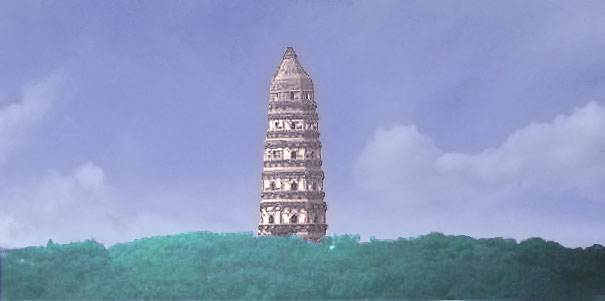 |
| During the Spring and Autumn Period (春秋時代 - 722-481 BC) China was comprised of over 150 kingdoms. Many of these kingdoms had existed for several hundred years before the rise of the Chinese dynasties. Under the Zhou Dynasty they had become vassal states. As the Zhou Dynasty weakened (the Spring and Autumn Period) the kingdoms again became independent, and began to move against one another.
The Yangtze delta of the Jiangnan region was largely within the Kingdom of Wu (吳). The Wu people had developed a culture as early as the 9th century BC. The Wu and the Yue to their south differed from their northern Chinese neighbors in language, customs, and beliefs. Even today, the Wu language is a distinct dialect in the region. During the Spring and Autumn Period the Kindom of Wu reemerged as a major power. In 515 BC King He Lü (阖闾) became king by assassinating his predecessor. In 514 BC he had a new city built at Suzhou (苏州) as his capital. In those days, Suzhou was called He Lü for obvious reasons. King He Lü spent considerable time on Tiger Hill (虎丘 Huqiu) if legends are true. He was a great collector of swords and as he acquired each, he tested them by running them across a large flat stone. The stone still lays upon the hill. Tiger Hill is 118 feet (36 meters) high and would have afforded an excellent defensive position. When he wasn't collecting swords, King He Lü was enlarging and strengthening his kingdom, primarily with battles against the Chu to the west. He was a very successful military commander. Perhaps because he had able advisors. Sunzi (孙子) or Sun-tzu, the military strategist who wrote the Art of War was one of two major advisors. Wu Zixü (伍子胥) was the second. Although not as well known in the West, he was just as important and brilliant. It was he that designed the great city of He Lü for the king, and was the architect of the plan that led to the defeat of the Chu. He had originally been a minister in Chu but had had to flee for his life to Wu, so he had a good lay of the land and a bone to pick. Under the three of them, Wu became quite powerful and wealthy. That wealth attracted the attention of the Yue to the south and they attacked. King He Lü was killed in battle in 495 BC and buried by his son, King Fu Chai (夫差). Legend has it that King He Lü was buried in a tomb on Tiger Hill with his collection of 3,000 swords. The 1,000 workers who built the tomb were killed to protect its secrets. After the funeral a white tiger was said to be seen laying on the tomb to protect it. Thus the name, Tiger Hill. In 486 BC King Fu Chai began work on a canal to link the Yangtze with the Huai River to the north. Within three years it was finished and King Fu Chai was able to use it to transport troops north to attack the Qi. This canal was so useful that work continued on it for next 900 years and it eventually served as the basis for the Grand Canal. King Fu Chai went on to conquer the Yue in 484 BC and capture their capital city. Wu Zixü counseled him to take over Yue, but instead he made a treaty with the king of Yue and commanded Wu Zixü to commit suicide. Within 10 years, the Yue overran the Kingdom of Wu and by 473 BC King Fu Chai was dead and the Kingdom of Wu ended. |
China Index >> History of Shanghai and Suzhou Region >> Suzhou
Click on a picture or use the arrows at the top to navigate through the site.
http://hua.umf.maine.edu/China/shanghai3.html
Last update: February 2007
© Marilyn Shea 1996, 1999, 2002, 2007